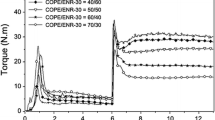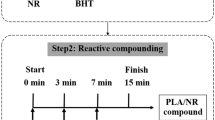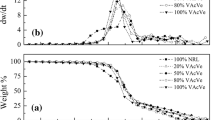Abstract
An intensive study has been undertaken on the damping mechanism of chlorinated butyl rubber (CIIR) and phenolic resin (PR) vulcanized blends. Evidence from morphology observations of blend sections by scanning electron microscopy, extraction experiments, molecular weight analysis by gel permeation chromatography indicates that except a part of PR crosslinked with CIIR, the others remain linear and disperse in the CIIR matrix to form a two-phase continuity. The tan δ curves of blend without striking peak split from the dynamic mechanical spectra and inward shift of glass transition of linear PR suggests that cured CIIR and linear PR is miscible to a certain extent, thus, the phase separation in the blends can be described as slight phase separation. There observations are interpreted in terms of variations of free volume characterized by positron annihilation lifetime spectroscopy.









Similar content being viewed by others
References
Brydson JA (1988) Rubber material and their properties, vol 8. Elsevier, London, p 1954
Houston, Texas (1998) Exxon Chem 6
Wu CF (2001) J Appl Polym Sci 80:2468
Liao FS, Su AC (1994) Polymer 35(12):3579
Boyer RF (1987) In: Keinath SE, Miller RL, Rieke JK (eds) Order in the amorphous state of polymer. Plenum, New York, p 135
Liao FS, Su AC (1994) Polymer 35(12):3579
He XR, Huang GS (2005) Chinese J Appl Chem 22(4):382
Luo QK (2004) China Synthtic Rubber Industry 27(1):26
Dutta NK, Tripathy DK (1990) Polym Degrad Stab 30:231
Capps RN (1986) Rubber Chem Technol 59:103
Pan J (1989) Aerospace Mater Technol 3:53
Chen BY, Ma GF (2005) World Rubber Industry 32(2):31
Ding GF, Wang JH (2004) Rubber Industry 51:571
Zhao YF, (2001) Aerospace Mater Technol 2:19
Hsieh TT, Tiu C (2000) Polymer 41:4737
Nakanishi H, Wang SJ, Jean YC (1988) In: Sharma SC (ed) Positron annihilation studies of fluids. Singapore, World Science; Singapore, p 292
Jean YC (1990) Macrochem J 42:72
Robert PL, Robert AK, Robert W (1989) Layer Rubber Chem Technol 62:10
Pritchard G (1980) Developments in Reinforced Plastics-I: Resin Matrix Aspects, Essex: Appl. Science Pub
Li HL, Ujihira Y, Nanasawa A, Jean YC (1999) Polymer 40:349
Acknowledgement
This work was financially supported by the National Natural Science Foundation of China (Grant No. 10276025) and the Ministry of Education (the Foundation for Ph.D. training, Grant No. 20040610027) of China.
Author information
Authors and Affiliations
Rights and permissions
About this article
Cite this article
Qu, L., Huang, G., Wu, J. et al. Damping mechanism of chlorobutyl rubber and phenolic resin vulcanized blends. J Mater Sci 42, 7256–7262 (2007). https://doi.org/10.1007/s10853-006-1466-9
Received:
Accepted:
Published:
Issue Date:
DOI: https://doi.org/10.1007/s10853-006-1466-9




